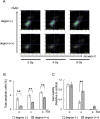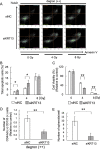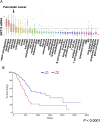KRT13 is upregulated in pancreatic cancer stem-like cells and associated with radioresistance
- PMID: 36610719
- PMCID: PMC10036105
- DOI: 10.1093/jrr/rrac091
KRT13 is upregulated in pancreatic cancer stem-like cells and associated with radioresistance
Abstract
Pancreatic cancer is one of the most aggressive cancers and the seventh leading cause of cancer-associated death in the world. Radiation is performed as an adjuvant therapy as well as anti-cancer drugs. Because cancer stem-like cells (CSCs) are considered to be radioresistant and cause recurrence and metastasis, understanding their properties is required for the development of novel therapeutic strategies. To investigate the CSC properties of pancreatic cancer cells, we used a pancreatic CSC model, degron (++) cells, which have low proteasome activity. Degron (++) cells displayed radioresistance in comparison with control cells. Using Ribonucleic acid (RNA) sequencing, we successfully identified KRT13 as a candidate gene responsible for radioresistance. Knockdown of KRT13 sensitized the degron (++) cells to radiation. Furthermore, a database search revealed that KRT13 is upregulated in pancreatic cancer cell lines and that high expression of KRT13 is associated with poorer prognosis. These results indicate that a combination therapy of KRT13 knockdown and radiation could hold therapeutic promise in pancreatic cancer.
Keywords: KRT13; cancer stem-like cell (CSC); pancreatic cancer; radioresistance.
© The Author(s) 2023. Published by Oxford University Press on behalf of The Japanese Radiation Research Society and Japanese Society for Radiation Oncology.
Conflict of interest statement
The authors declare no potential conflicts of interest.
Figures




References
-
- Sung H, Ferlay J, Siegel RL et al. Global cancer statistics 2020: GLOBOCAN estimates of incidence and mortality worldwide for 36 cancers in 185 countries. CA Cancer J Clin 2021;71:209–49. - PubMed
-
- Khan AQ, Rashid K, AlAmodi AA et al. Recent developments in unraveling signaling mechanisms underlying drug resistance due to cancer stem-like cells. Curr Opin Pharmacol 2020;54:130–41. - PubMed
-
- Baek SJ, Ishii H, Tamari K et al. Cancer stem cells: the potential of carbon ion beam radiation and new radiosensitizers (review). Oncol Rep 2015;34:2233–7. - PubMed
MeSH terms
Substances
Grants and funding
LinkOut - more resources
Full Text Sources
Medical
Molecular Biology Databases
Research Materials

